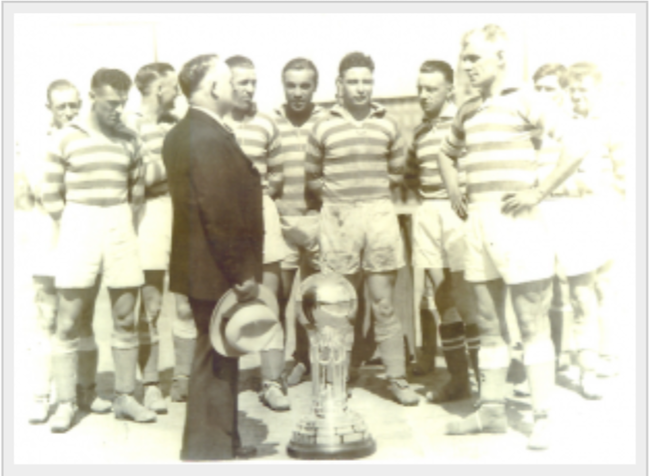
Many thanks to Ed Farnsworth and Tom McCabe for their help and comments. Any errors below are my own.
A special thank you to my wife Michaela and children Rose and Lenna for their patience and support while I did the research and work.
Fall River, Massachusetts was a preeminent American soccer scene of the late nineteenth century. Strong clubs like the East Ends, Olympics and Rovers represented the city in national competitions, dominating the American Football Association’s American Cup tournament in the late 1880s and early 1890s. In 1917, the Rovers won the US Open Cup.[1] Soon, another golden era of Fall River soccer began with the arrival of the Fall River Marksmen. This year marks the one hundredth anniversary of the Marksmen’s founding. The Marksmen became one of the most successful sides of their day, winning six American Soccer League championships and the US Open Cup, then known as the National Challenge Cup, four times through 1931.[2]
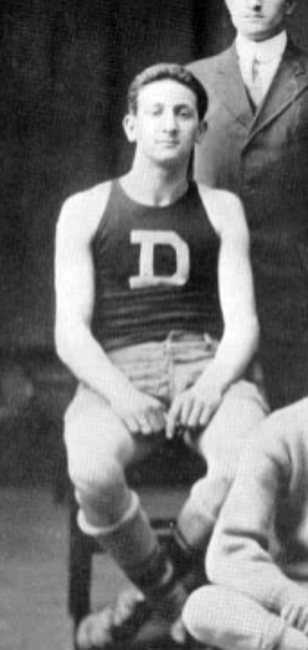
The architect behind the Marksmen was Samuel Markelevich (Sam Mark), a Fall River businessman and sports promoter. Mark was known for his athletic prowess, keen eye for identifying talent in the ruthless pursuit to win championships. The club took on the “Marksmen” moniker because of Sam Mark’s tenacity and commitment to bring Fall River back to the top of the American soccer world. Interestingly, Mark was not a soccer fan, as he specialized in baseball and basketball. But in 1922, an opportunity arose to get involved in the local soccer scene, and Mark took advantage of a dispute between the Fall River Uniteds and Rovers over the sharing of the Bedford Street Athletic Grounds, one of the city’s historic soccer fields.[3]
A flying start
On July 22, 1922, Sam Mark met with United States Football Association secretary Thomas Cahill to secure ownership of the Fall River American Soccer League franchise (the Uniteds) in order to keep a professional ASL club in the city.[4] Mark promised he would work to create the strongest club possible; if anyone else thought they could do better, he invited them to try.[5] No one took up the challenge. Mark secured land in nearby Tiverton, Rhode Island to build a soccer-specific stadium, to avoid Massachusetts blue laws.[6] He then started scouting and recruiting current ASL talent, bringing in leading players like Harry Ratican, Bob Millar, John Jaap, Neil Clark, Frank Booth, Albert Lynn, and Harold Brittan.[7]
The Marksmen soon began practice sessions and started scheduling exhibitions to prepare for their first ASL season. Locals were excited about the club and eager to see the new stadium and Mark’s men in action.[8] The Marksmen’s first match was on September 24, 1922, an exhibition against the Bleachers of Saylesville, Rhode Island. Wearing green and gold uniforms, the Marksmen played a hard fought draw at the yet-to-be completed Mark’s Stadium in front of 3,000 fans. Down by three goals at half, the Marksmen stormed back to tie the game. The club’s first-ever home win came on October 12, 1922, a 4-2 victory over Rhode Island’s Fairlawn Rovers.
The Marksmen had a bumpy start to the 1922-23 ASL season, losing the first two games, only scoring twice while conceding five goals. Fred Pepper scored the first official goal for the Marksmen in a loss to New York FC.[9] The team finally began to find its stride when they recorded their first-ever league victory over Harrison SC in New Jersey. The Marksmen had their first taste of the National Challenge Cup in mid October, scoring a 4-0 victory over J&P Coats II, but lost in the next round to J&P Coats’ first team on November 4, 1922. The Marksmen then went on a very good run of form and by early January they were top of the ASL. Unfortunately, poor form hit in the New Year as the club took some heavy losses. This prompted Mark to scout in Canada and in the United Kingdom to find a few more top players, one being Bill McPherson.
The Marksmen finished third in the 1922-23 ASL season, with J&P Coats narrowly winning the crown ahead of Bethlehem Steel. High notes for the inaugural season were Harold Brittan netting 19 goals, Johnny Reid making 26 appearances, a 2-2 draw in an exhibition against England’s Dick, Kerr Ladies, and a 3-1 exhibition victory versus Philadelphia amateur side Fleischer Yarn, winners of the 1923 American Cup.
In the offseason, Mark once again recruited players in Canada and the United Kingdom, while also keeping an eye on players moving within the league. The Marksmen were able to create a much stronger lineup and went on long runs in all competitions in the 1923-24 season. Findlay Kerr, Ned Tate, Bill Fryer and Fred Morely were key acquisitions for the club and helped solidify the team.[10]
In the National Challenge Cup and the American Cup, the club had some hotly-contested games and memorable victories. Fifteen thousand supporters witnessed the Marksmen dominate J&P Coats at Mark’s Stadium in mid November, 1923 in a National Challenge Cup replay. The Marksmen also went on a nine-match undefeated streak in ASL play, jumping to the top of the league.
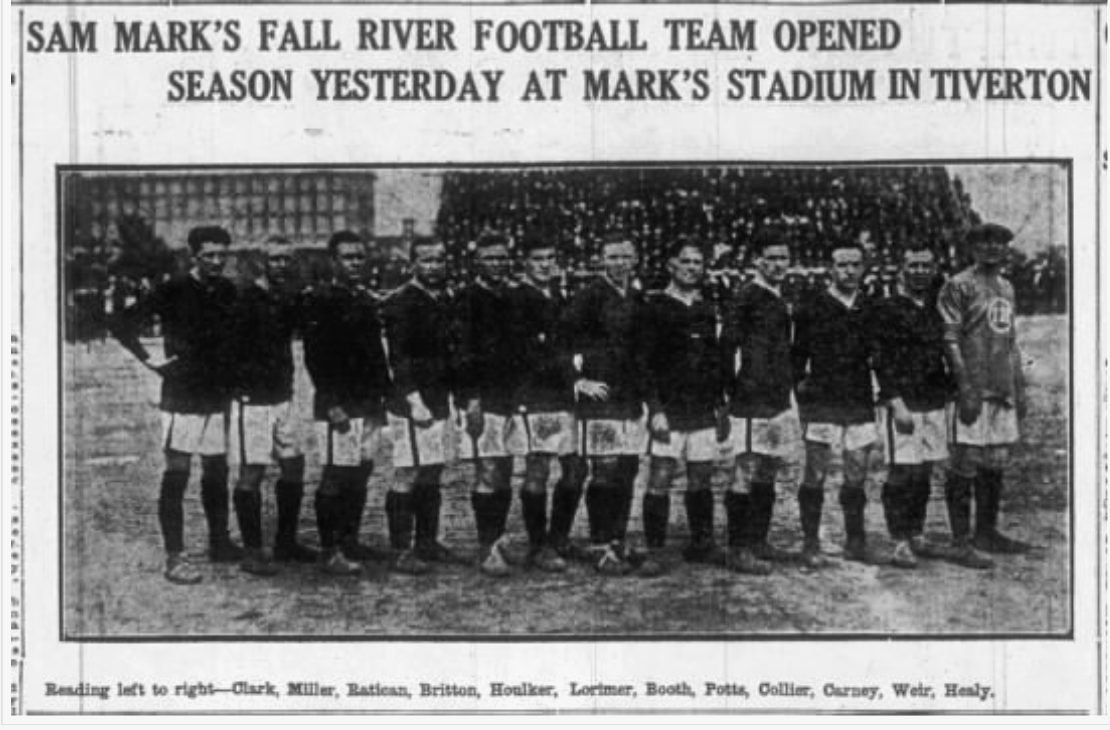
Led by a strong defense, the Marksmen lost in league play just twice (both to Bethlehem Steel), winning 19 out of 27 games to take the ASL title. The defense allowed only nineteen goals all year. Their dominant play saw the team cruise to the finals of both the National Challenge Cup and American Cup. The rivalry with Bethlehem continued with a 2-0 semifinal win over the Steelmen in the National Challenge Cup on March 9, 1924. With a 4-2 victory over Vesper Buick in St. Louis the Marksmen secured the double and lifted the Dewar Trophy for their first National Challenge Cup title. A one-goal loss to Bethlehem in the American Cup final prevented the team from winning the treble. The Marksmen finished with a 37-9-3 record with 120 goals for and 39 against in all competitions.
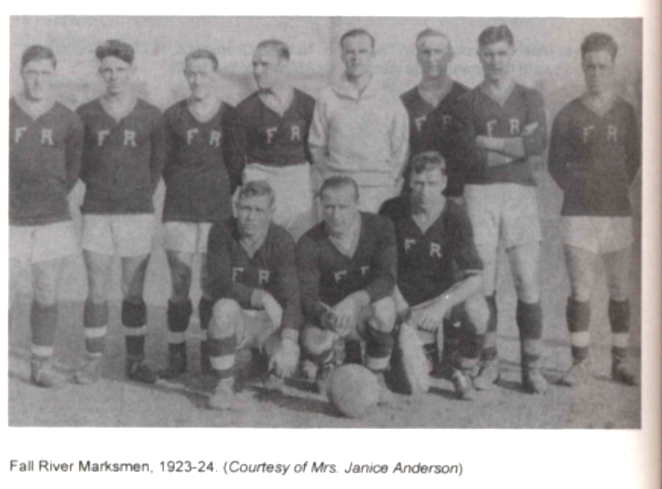
Building on success
The ASL expanded from eight to twelve teams in the 1924-25 season and added three more local rivals for the Marksmen, including the Boston Wonder Workers, New Bedford Whalers and Providence FC. These new teams and the increase to a forty-four league schedule prompted clubs to look for both talent and depth, which intensified rivalries before they even stepped on the field. Mark continued to recruit players both within the league and overseas.
The Marksmen started their title defense with Harold Brittan as Captain-Manager. Due to a dispute between Mark and ASL secretary Tom Cahill, the Marksmen did not enter the 1924-25 National Challenge Cup tournament.[11] Instead, the Marksmen set their eyes on the Lewis Cup, an ASL cup competition.
Early season worries included McPherson’s fractured wrists following a bad fall in preseason, but a rotation of Ned Tate, Tommy Raeside and Bill Fryer worked out and the Marksmen only lost one game during McPherson’s absence.[12] Shortly after his return, the club raised the ASL and National Challenge Cup championship pennants in a ceremony at Mark’s Field that included the Rhode Island Governor William S. Flynn, the honorable Judge Edward F. Hanify of Fall River, and Tiverton Town Council members.[13] The Marksmen marked the occasion by defeating Fleischer Yarn in front of seven thousand spectators. The good form continued through the fall and the Marksmen had only four losses in twenty-seven matches, putting them in a neck-and-neck race with Bethlehem for first place.
Play in the League Cup began after the New Year and the Marksmen saw their main New England rivals at every turn on the way to the final. On January 25, 1925, the Marksmen won a 3-2 double overtime victory against Providence at Mark’s Stadium with 7,400 in attendance. The club finished the game with only ten men when Fred Morley was injured before overtime started. The game was described as rough, yet thrillingly skillful for the crowd on hand.[14] League contests were often filled with rough tackles, shouting matches and the occasional fight.
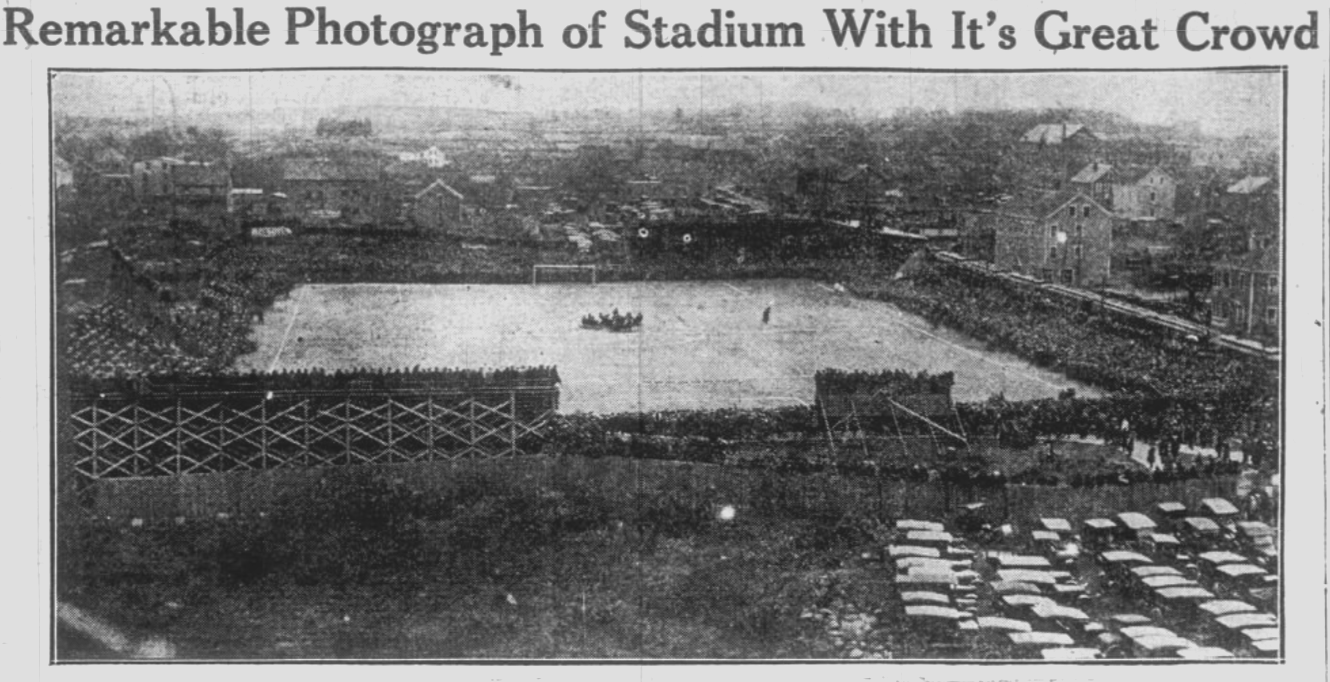
The Marksmen secured a berth into the semifinal with a 3-0 victory over J&P Coats at Mark’s Stadium in the next round. Seven thousand fans endured the rain to witness the Marksmen put on a show highlighted by Findlay Kerr’s penalty kick save.[15] When the New Bedford came to Mark’s Stadium for the semifinal, the Marksmen dominated the Whalers in a convincing 3-0 victory.
To the chagrin of other New England clubs who had hoped to be named host, the final was played at Mark’s Stadium. The decision was controversial among local journalists in Southern New England, but Boston expressed no concern and embraced the challenge.[16] Sam Mark quickly set out to have additional seating and standing room added to the stadium. Unfortunately, the weather didn’t cooperate on March 29, 1925, and the attendance was well below what was expected with 9,800 fans. The match also did not end the way the locals wanted, as Boston won to take the Lewis Cup back home. Mickey Hamill had a great game and future Marksmen legend, Alex McNab, scored the winner a few minutes from full-time to further dampen the day for local fans.[17]
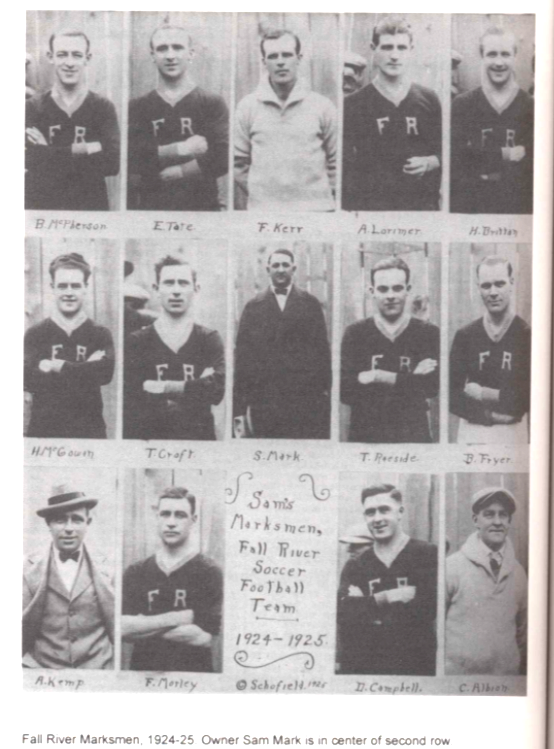
Even though losing the final was a disappointing finish to the Lewis Cup competition, the Marksmen continued their run through the league. The Fall River side lost only one of their last seventeen league games, a span that included lopsided victories over Philadelphia (5-1), Newark (7-0) and Fleischer Yarn (9-0). Most importantly, the Marksmen won the season series against Bethlehem to edge the Steel out in the title race and secure their second straight ASL title.
Kings of the league, but falling for the Cup
With back-to-back ASL titles, a National Challenge Cup title and a runner-up in the American Cup, the Marksmen had placed a target on their back. Sam Mark knew going into the 1925-1926 season he could not let up on his scouting. On a scouting trip in Montreal in July 1925 his car was stolen.[18] Local papers in Scotland followed his every move during a scouting trip to the United Kingdom in which Mark was able to secure the services of five players: James “Tec” White of Motherwell, Charlie McGill of Hearts, Hugh Coyle of Motherwell, Tommy Martin of Motherwell, and Bill Forbes of Plymouth Argyle.[19] This opened doors for Harry McGowan, Alex Kemp, Frank McKenna and Alex Lorimer to leave the club, some of them joining Shawsheen (McGown and Lorimer).[20]
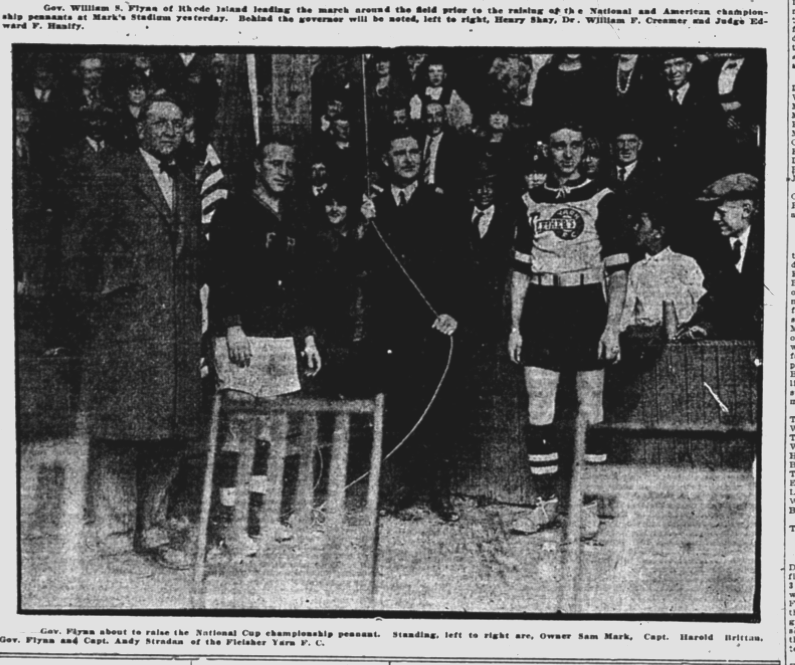
Tommy Croft, the great Irish International, had been a key figure in his first year for the Marksmen before returning to Ireland for vacation. Upon arrival in Ireland, Croft was hit with difficult news: Queen’s Island, his former club, claimed he had broken his contract because they were in talks with a club in Scotland before he left for America.[21] Tommy’s future with the Marksmen depended on the decision of the court in Ireland. Thankfully the court ruled in his favor and Croft was able to return to the Marksmen.[22]
The ASL considered several changes to its competition rules ahead of the 1925-26 season, including altering the offside rule and allowing substitutions. But most national and local journalists opposed such ideas as threatening “the integrity” of the game.[23] The most important change was a shift from a point total to a winning percentage for determining the league’s standings. The change was motivated by the fact that many teams would not finish out a season, especially if they were out of the running.
The Marksmen lost only once between September and January. Amazingly, that single loss came in an away game against newcomers Shawsheen on September 19, 1925. At one point the club won seven straight matches, helping them cement first place in the standings. During this run the Marksmen thrashed clubs like Philadelphia, Newark and Shawsheen. Stronger rivals like Bethlehem and New Bedford took their licks from the Marksmen throughout the year, too.
The Marksmen’s main disappointments in the 1925-26 season were poor showings in the National Challenge Cup and Lewis Cup. On January 17, 1926. The Marksmen defeated Providence in the National Challenge Cup, leading to a showdown with Boston, the “Woodsies.” The first match on February 14, 1926, was a draw at Mark’s Stadium after Sam Mark spent $1,000 to clear the field of ice and snow for seven thousand fans to see a game of physicality and skill. Unfortunately, Bill McPherson had his penalty saved by Tommy Steel after Boston went down to ten men.[24] In the replay on February 21, 1926, Boston won by a goal in front of twelve thousand at Mark’s Stadium. Alex McNab again put in a strong performance and scored one of the Marksmen’s goals. The two clubs continued to battle in League Cup play after being drawn together in the first round.[25]
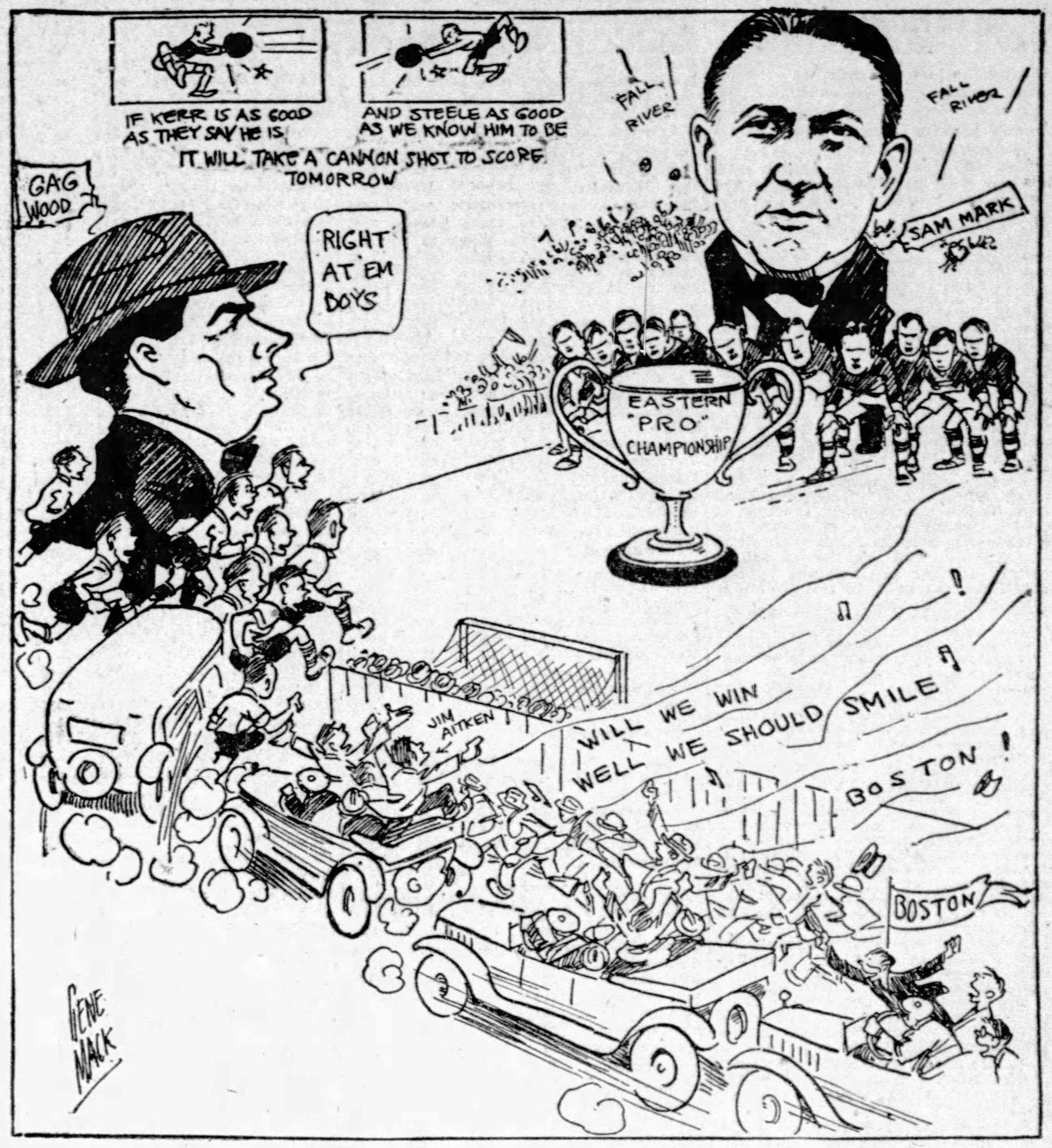
Boston again disappointed the Fall River fans and stumped the Marksmen on the field. On April 18, 1926, the teams played to a 2-2 overtime draw at Mark’s Stadium, with Steel making another penalty save against McPherson. Once again Boston came out on top in the replay, defeating the Marksmen at Boston’s Walpole Street Grounds. The result led the Boston Globe’s George Collins to write, “The Fall River players do not seem to be able to outclass the Boston men. There seems to be something wrong with ‘murderers row’ when it faces the Woodsies defense.”[26]
Following their cup competition disappointments, the Marksmen were able to focus on their electric run of league form, losing just one league match after the New Year, a defeat to Indiana Flooring on March 21, 1926. The Marksmen’s dominance in the league was aided by the acquisitions of Coyle, McGill, White and Tommy Blair. The backline was solidified with Hugh Coyle, Bill McPherson and Charlie McGill while James “Tec” White was the club’s leading goal scorer, netting twelve more goals than Harold Brittan.
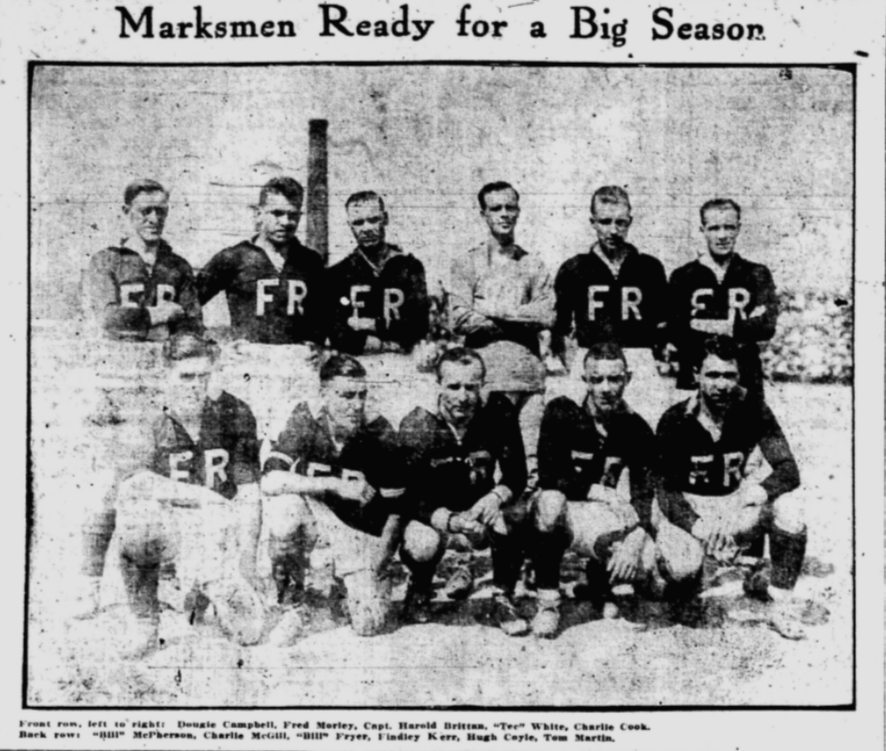
Another dominant league season gave the Marksmen their three-peat of ASL titles, finishing with a 30-2-12 record for the 1925-1926 season. The final points total was 72, which was good for a .819 win percentage. They had the best defense in the league for the third year in a row, allowing 51 goals in 44 games, and the best offense with 142 goals scored. Other highlights include James “Tec” White scoring 33, Harold Brittan scoring 21 and Tommy Croft scoring 19.
Foreign challengers and Cup champions
The Marksmen name started to draw notice from European clubs – Sparta Prague added Fall River to their tour of the United States in 1926 – but Sam Mark’s focus remained on assembling the best possible group of players possible. Key acquisitions ahead of the 1926-27 season included David McEachran of Clydebank, Sam Kennedy of Clyde, and Tewfik “Happy” Abdullah.[27] Mark then shook things up by naming Fred Morley the new captain-manager in place of Harold Brittan, who had yet to sign a new contract.[28] Brittan eventually decided to leave the club and signed with nearby rival, New Bedford.[29]
New club Springfield Babes shocked the Marksmen by defeating them on September 11, 1926. The next day the Marksmen defeated Boston with Tec White and David McEacheran scoring the goals. The Marksmen lost three games in all competitions in 1924-25, suffering only two league losses in 1925-26. Over the first six games of the 1926-27 season, they lost three games. It was a harbinger of what the team would experience for the rest of the year, a roller coaster of ups and downs in league and tournament play.
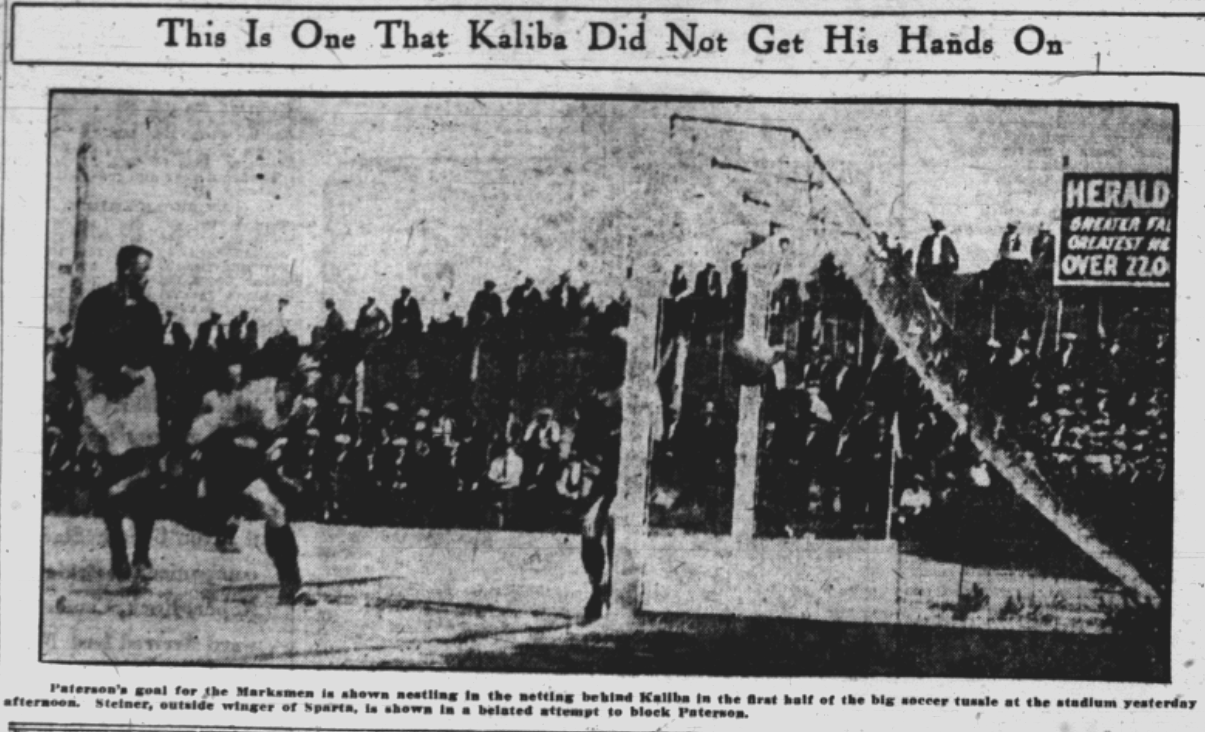
Still, the highs were good. On September 19, 1926, the Marksmen defeated Springfield in league play and then defeated Sparta Prague immediately following the end of the league game. Two games in one day and they were able to win both in impressive fashion. The game was fast paced and rough at times and included Sparta’s injured goalkeeper, Hochman, entering the field of play after taking exception to a hard challenge on one of his teammates.[30] The final score was 3-2 to the Marksmen, Sparta Prague’s first loss on their tour of America.
The rest of the ASL season remained difficult for the Marksmen, who saw disappointing results against weak opponents: two losses to Philadelphia, losses to both Brooklyn and Providence, and draws at Springfield and Indiana Flooring. As a result, the Marksmen finished the season outside of first place for just the second time in club history. The Marksmen finished with a 24-12-8 record, 56 points gained with a win percentage of .636 in 44 games. They finished with 98 goals scored and 72 goals allowed, one of their worst defensive seasons to date.
The Lewis Cup offered no reprieve as the Marksmen were ousted by Brooklyn over two games. The first game was in Brooklyn on February 27, 1927, with Sam Kennedy scoring for the Marksmen. The replay saw Brooklyn shock Fall River in front of ten thousand fans at Mark’s Stadium. Tewfik “Happy” Abdullah scored for the Marksmen after replacing Bill Paterson. Shortly after this game on March 10, 1927, it was announced that New Bedford and Fall River agreed on a trade that saw Harold Brittan back to the Marksmen. Brittan played in the National Challenge Cup for the Marksmen for the remainder of the 1926-1927 season.[31]
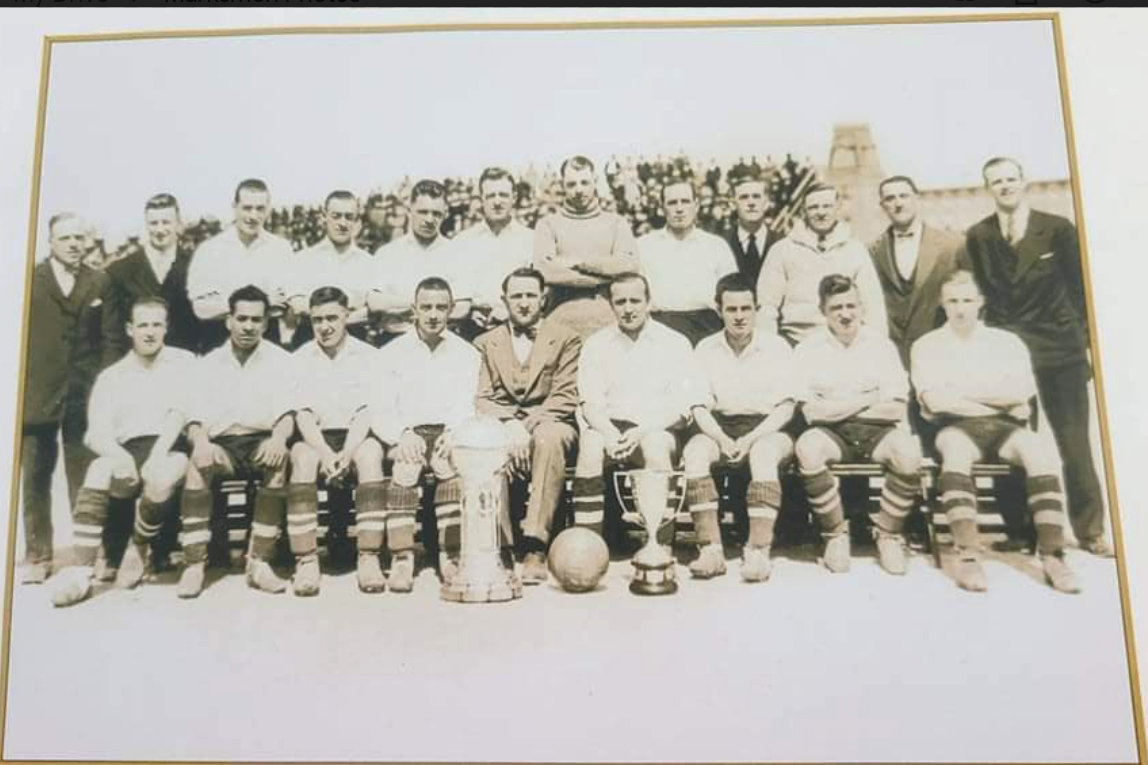
The pain of an unsatisfactory ASL season and Lewis Cup play was diminished by a terrific run in the National Challenge Cup that finished with the Marksmen securing their second Dewar Trophy. The run started with New Bedford on March 27, 1927 with fourteen thousand spectators on hand to watch a hard fought and physical win at Mark’s Stadium.[32] Next up were the “Shipbuilders” of Fore River out of Quincy, Massachusetts. On April 3, the Marksmen thrashed Fore River by five goals at Mark’s Stadium. An overtime match against Providence proved to be a classic. The winning goal was scored by James White, who pounced on a rebound from a free kick taken by Bill McPherson.[33] The semifinal match was a heavyweight battle between Fall River and Bethlehem and was hosted at a neutral site to determine the representative from the East. The Marksmen’s David McEachran headed home the winner just before halftime in what finished as a 2-1 win.[34]
That result meant the Fall River Marksmen would face Holley Carburetor for the final in Detroit, Michigan. The final was not close, and the Marksmen romped to a 7-0 victory, the scoreline easily could have been worse. The ten thousand fans who packed the University of Detroit Stadium witnessed great passing skills, combination play and individual talent as the Marksmen outclassed their Western adversaries. Harold Brittan scored the first on a goalmouth scramble after good passing plays. Tommy Blair stopped a penalty from Gerret Visser. David McEachran scored twice along with James White to round off the highlights.[35]
Another highlight of the season was the April 10, 1927, exhibition match against the Uruguayan national team, who had won the gold medal at the 1924 Olympic games in Paris, and would go on to win gold again in the 1928 Olympic games in Amsterdam. The Marksmen drew with what was considered one of the greatest sides in the world at that time. The game, played in front of a crowd of four thousand at Mark’s Stadium, was fast and skillful, but lacked the physicality that was present in other exhibitions for the gold medalists. James “Tec” White put the Marksmen ahead at halftime 1-0. The second half saw the Uruguayans control the play and they equalized with a powerful shot that Tommy Blair could not stop.[36]
A barren campaign
Due to their success in the National Challenge Cup, many felt the Marksmen would be able to defend their title and be contenders for the 1927-1928 ASL championship. Sam Mark seemed to have shared the same sentiment and he did not make many changes to the roster except for signing William ”Bill” Harper from Arsenal, trading to bring back Ned Tate, and reappointing Harold Brittan player-manager.[37] Key departures included Findaly Kerr transferred J&P Coats, Twefik Abdullah and Tommy Blair transferred to Hartford, and Billy Hyslop and Johnny Caldwell returning to Scotland.
The ASL introduced a new format ahead of the 1927-28 season that included a break in play in January and a playoff series to crown the league champion. The league roster stayed at twelve teams, but there were still changes and new faces. Hartford was awarded a franchise and were known as the Americans. Indiana Flooring were bought by Charles Stoneham who changed the club name to the New York Nationals. Philadelphia Field Club became known as Philadelphia Celtic after being bought by Fred McGuiness. The season was disastrous for Philadelphia and Hartford who both ran into significant financial struggles with their owners, resulting in Philadelphia suspending operations after ten games. The league then requested Hartford to do the same after eleven games. Players from both teams were dispersed throughout the league.[38]
League results were not what the Marksmen expected. The first half of the season saw Fall River in fifth place with a 14-11-6 record as the defense and new goalkeeper Bill Harper struggled. This prompted Sam Mark to again go overseas and acquire anyone he could in the league through trade or as free transfers. Local fans were frustrated and disappointed but good attendance continued to fill Mark’s Stadium. Ten thousand fans watched as the Marksmen lost 4-2 to New Bedford on September 25, 1927.[39] Mark soon signed Jimmy Douglas to alleviate pressure for Bill Harper, who picked up an injury.[40] Mark also made a good trade in sending David Gibson to Providence for Bob McAuley.[41] Unfortunately, there were few highlights for the first half of the season, which included two wins over New Bedford, a 7-1 home victory and 1-0 win away.
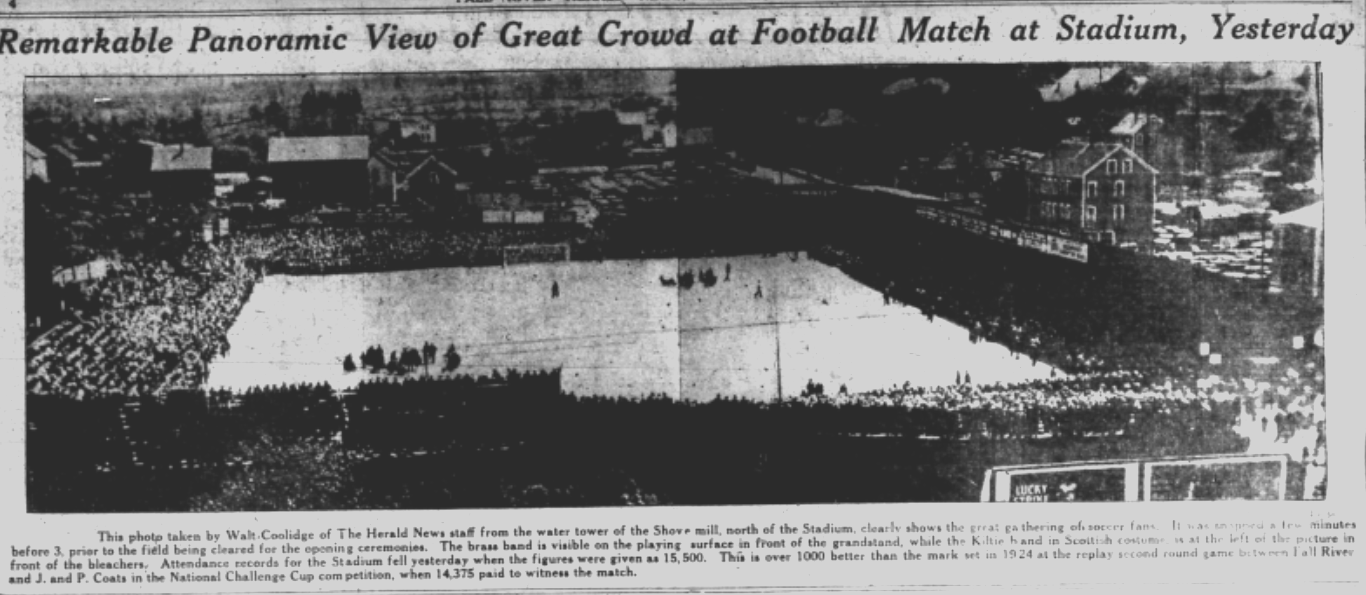
In the National Challenge Cup, the Marksmen also fell short. Challenge Cup play began with a strong 5-0 victory over Mackenzie AFC of Niagara, NY in January of 1928, followed by a tie with Boston. The Marksmen then pulled out a great 2-1 victory again at home in the replay on January 29, 1928.[42] J&P Coats were next, and they were the wall that stopped the Marksmen. On February 26, 1928, the Coats were able to down the Marksmen 2-1 in Providence. Six thousand saw the Marksmen upset after being favored and having the better run of play most of the game.[43]
Lewis Cup play began in January and the Marksmen saw a shorter run and more disappointment for their fans. The opening round placed the Marksmen against J&P Coats with the competition played in an aggregate format; the games were back to back starting on January 21, 1928, a 0-0 draw in Pawtucket. The next day the Marksmen defeated the Coats 4-2 at Mark’s Stadium with McPherson, White, Brittan and McEacheran scoring.[44] The Marksmen next lost the first leg in Boston on March 3, 1928, 2-0 before coming home the next day to Mark’s Stadium. There the Marksmen won 3-2, but Boston won 4-3 on aggregate.[45]
The second half of the ASL season was a different story and Harold Brittan was able to get his forces to gel and play together more effectively. The Marksmen defense improved significantly while the offense continued to be lethal, and this led to success. The improved form led to a 15-6-5 record and a second-place finish and a playoff berth. The Marksmen finished the 1927-28 season with a combined record of 29-17-11, 69 points, scoring 138 goals and allowing 91 goals for a win percentage of .548/.673 in the two halves of the season. In the ASL playoffs, Fall River faced rivals New Bedford, who had finished first in the second half.[46]
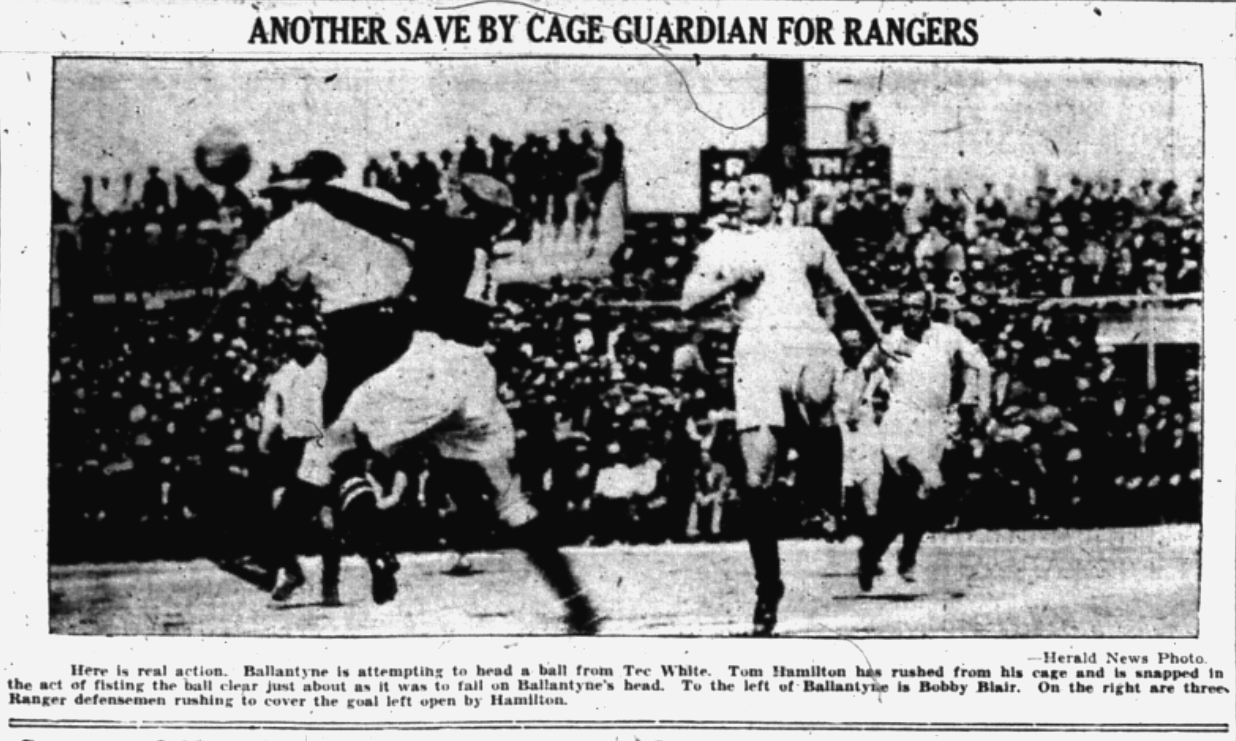
The playoff against the New Bedford Whalers was played over a two-leg on back-to-back days on June 9 and June 10, 1928. Once again, Tommy Steel, former goalkeeper for Boston, seemed to have Fall River’s number. The game was intense and only Bobby Blair was able to get on the score sheet for the Marksmen, who lost 2-1. The return leg at Mark’s Stadium saw a determined Marksmen group backed by a rowdy crowd, but again Tommy Steel stole the show for the Whalers, who held the Marksmen to only a 1-0 victory. With the 3-2 aggregate win, New Bedford advanced to face Boston in the single game final. Boston won 4-2 at Battery Park, the first time since its founding the Marksmen finished the season with no trophies.
One highlight of the season was in an exhibition match with Rangers, Champions of Scotland, who were touring the United States. Fifteen thousand and five hundred fans crammed into Mark’s Stadium as the Marksmen frustrated the Scottish giants in a 0-0 draw on June 3, 1928. Johnny Ballantyne had his goal ruled offside in the last 10 minutes of play, saving the Rangers from losing. Both clubs put on a classy display for the fans while Jimmy Douglas put on a stellar performance between the sticks.[47]
Soccer War woes
The 1928-29 season saw chaos in the ASL and the American soccer landscape, marked by the “Soccer War” between the league and the USFA. The conflict marked the start of a downward spiral for the league and many of its clubs, which worsened as the effects of the Great Depression began to take toll on the US economy. The league became an outlaw league after being suspended by the USFA for refusal to participate in the National Challenge Cup due to disputes over scheduling and the sharing of gate revenue. Consequently, the league dropped from ten teams to seven as Bethlehem Steel, New York Giants and Newark joined the newly established Eastern Soccer League after the ASL fined them for entering the National Challenge Cup.[48]
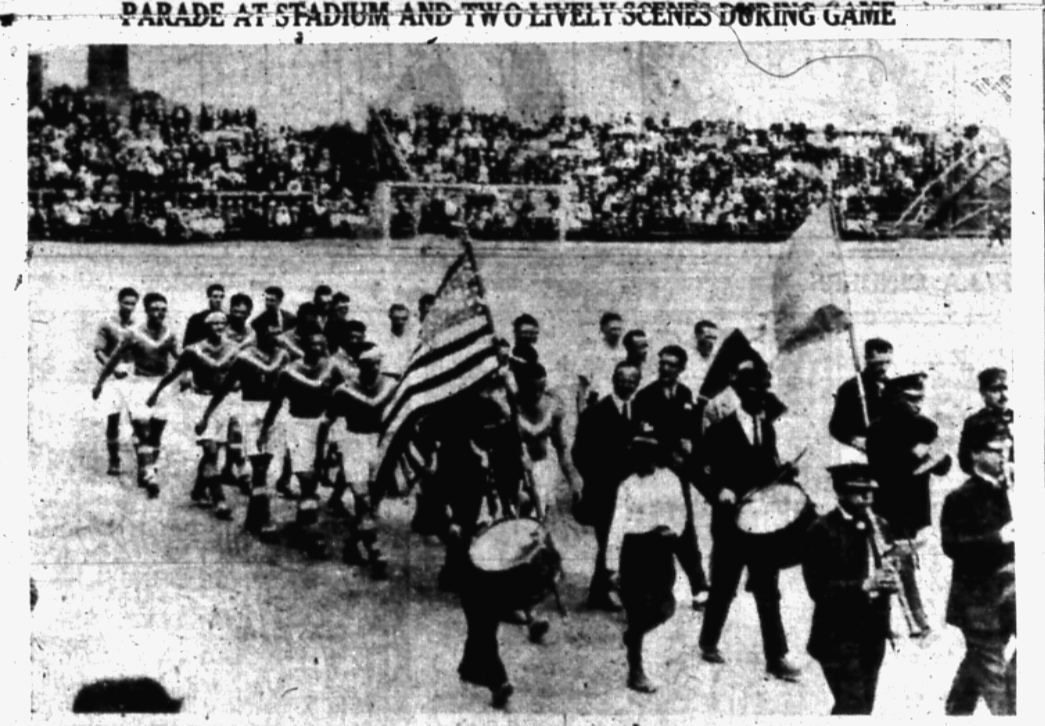
Prior to the start of the season the Marksmen hosted Palestra Italia XI (Brescia) in a preseason exhibition match on August 26, 1928. This provided a good test for the Marksmen going into the season and pleased the local crowd with a 4-2 victory. Tempers flared a bit from the rough play and Sam Mark himself had to enter the field to calm his players as the referee corralled the opposition. Bobby Blair scored all four goals for the Marksmen as the team outclassed the Italians in front of three and a half thousand fans.[49]
The first half of the ASL season went extremely well for the Marksmen. Bill Harper was excellent in goal and the defense was led by Bill McPherson and Charlie McGill. The acquisition of Alex McNab and hometown heroes, Bert Patenaude and Milton Gavin, strengthened the already lethal offense. Marksmen supporters were treated to great soccer and were happy to see the kind of skillful and dominant performances familiar from earlier in the club’s history. Granted, the Marksmen did not have Bethlehem to deal with, but local New England rivals and other teams remained difficult challenges. The Marksmen won the first half of the season with a 17-5-9 record, having the best defense in the league with only 26 goals allowed while scoring 64 goals for 43 points and a win percentage of .693.
As strong as the first half was, the Marksmen did not fare as well with their cup runs and faced familiar rivals in both competitions. In the Lewis Cup, the Marksmen first faced Boston and were able to take the aggregate 4-2. Next the Marksmen faced New Bedford. On January 5, 1929, the two rivals played to a 1-1 draw at Battery Park in New Bedford. The next day at Mark’s Stadium the Marksmen were defeated 3-2, losing on aggregate 4-3 to be eliminated from the tournament.
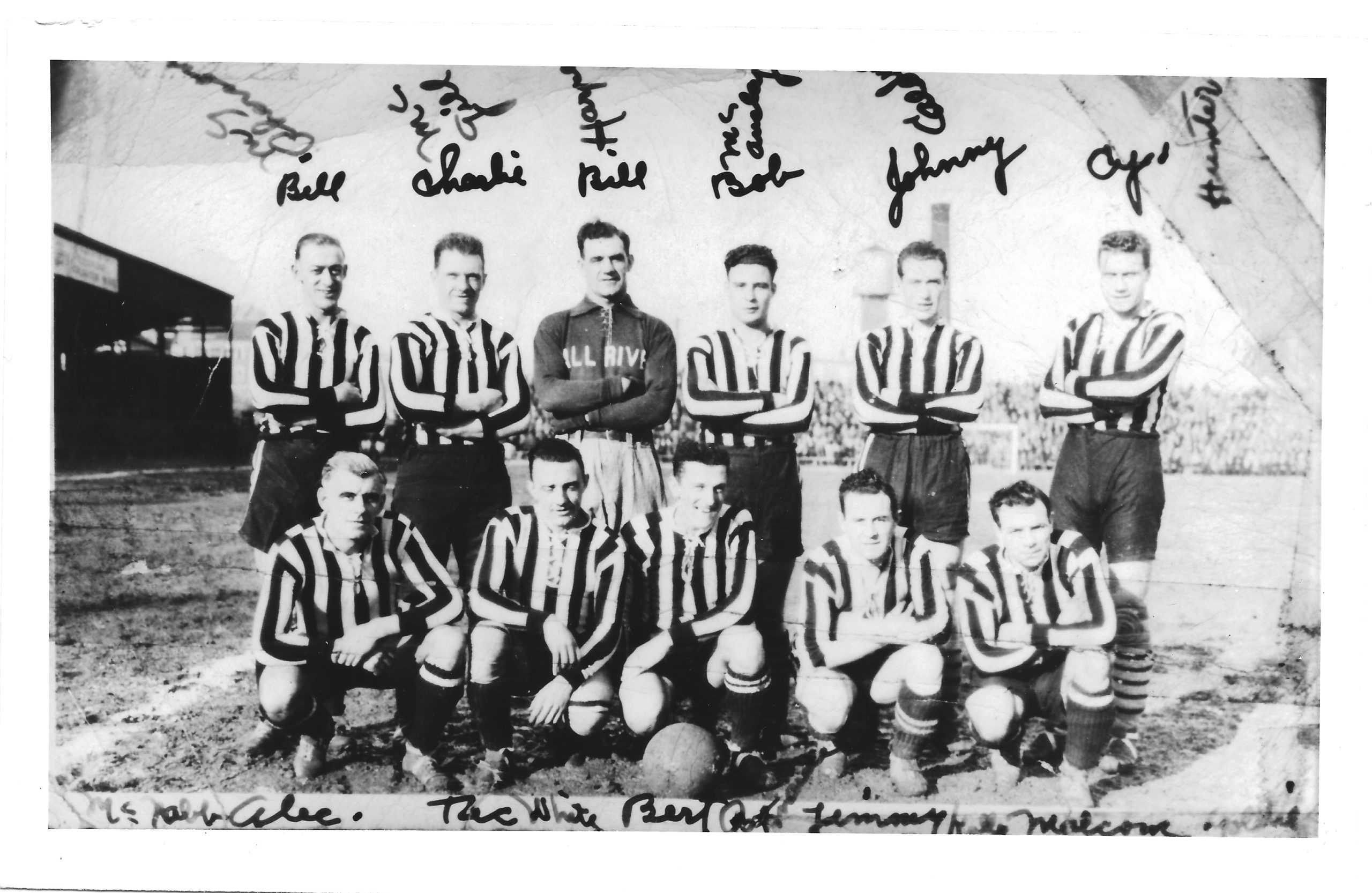
The second half of the season saw much of the same dominance from the Marksmen, but the New Bedford Whalers dropped out halfway through and joined the Eastern Soccer League, causing a schedule complication for the ASL and the remaining teams. With new ownership, J&P Coats rebranded as the Pawtucket Rangers. The American Association Cup competition began play in April 1929 but ended quickly for the Marksmen, who were eliminated by Boston in the first round 7-5 on aggregate following a 4-2 road loss on April 27 and a 3-3 draw the following day at Mark’s Stadium.
In league play, the Marksmen defense continued to be the strongpoint for the club and led the league again in fewest goals allowed. The Marksmen finished the second half of the season in first again with a record of 11-5-6, scoring 46 goals and allowing 26 for 28 points and a win percentage of .636. The games were closer, but Fall River still handled their rivals well with wins over Boston, New Bedford, Providence, and Pawtucket. Because the Marksmen won both halves, they were declared champions for the season with no playoffs being played. Local fans had a fourth league title to celebrate.[50]
The treble
The 1929-30 season began with fewer ASL teams and the feud with the USFA ongoing. The Marksmen continued strengthening their team with acquisitions such as local hero Billy Goncalves from Boston along with Warner Nielsen. Another local Fall River star was John Reder, who replaced Bill Harper in net.
Peace with the USFA came in October 1929 with the merger of the ASL and ESL to form the Atlantic Coast League. With the merger the ASL ended its season in October and the Marksmen were declared champions based on their superior winning percentage of .750 over 22 games, a record of 15-4-3 while scoring 65 goals and allowing 40 goals. Second place Providence also played 22 games but finished with a .682 win percentage.[51]
The merger of the ASL and ESL meant changes in the roster of teams. The newly formed Bridgeport Bears club had to relocate to Philadelphia after financial struggles and poor attendance. Brooklyn Hakoah joined the league but soon changed their name to the Hakoah All Stars when it merged with New York Hakoah of the ESL. Providence changed their nickname from the Clamdiggers to the Gold Bugs. Boston became known as the Bears before dropping out of the league in the second half of the season. The league itself soon readopted the American Soccer League name.[52]
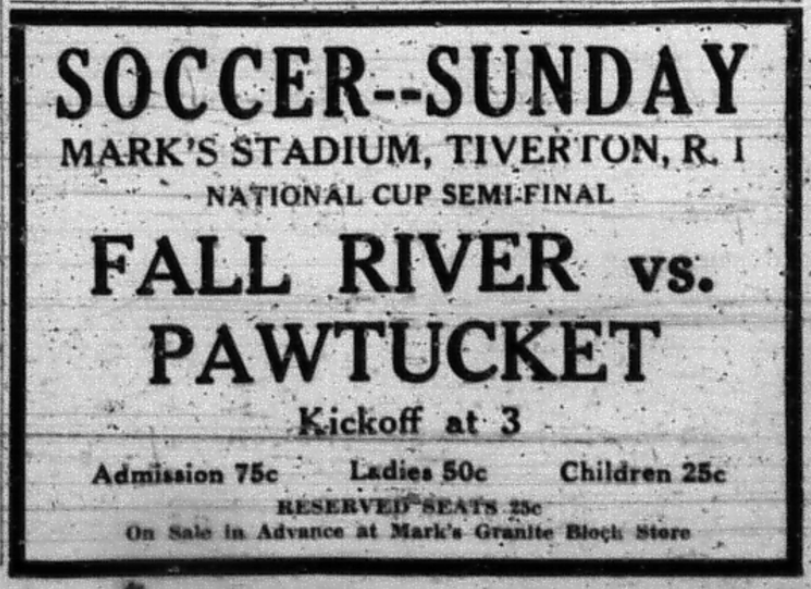
Now that the leagues merged, the new ASL first half of the 1929-1930 season started in November 1929, running through April 1930. While the second half of the season started in September 1930 and ended in January 1931. The Marksmen returned to their dominant ways with their most dominant Marksmen lineup ever, steamrolling through both halves of the league season and cruising through the National Challenge Cup and Lewis Cup to reach the finals in both tournaments. The club played international friendlies against Glasgow Rangers and Kilmarnock in May and June of 1930. The club also embarked on a Central European tour in August 1930, delaying the start of the second half of the season.[53]
The first half of the season was nearly perfect for the Marksmen as the club went on a 18-game unbeaten streak and lost their only game to Providence 1-0. The amazing run of form ended with the team finishing in first with a 19-1-7 record and a win percentage of .814. The Marksmen began their National Challenge Cup campaign in February 1930 against Lusitania Recreation, winning easily to advance and face New Bedford. The Whalers proved to be no match and fell to the Marksmen 5-2 at Mark’s Stadium on February 22, 1930. Next was Pawtucket, who also fell 5-2 at Mark’s Stadium, leading to a classic matchup with the Bethlehem Steel.

With the popularity of the Marksmen at that time and the struggle of the Depression impacting attendance at Mark’s Stadium, Sam Mark had no issue with the game being played at the Polo Grounds in New York as a neutral site. Thirteen thousand spectators were on hand for a 1-1 overtime draw with Bethlehem.[54] The replay held in New Bedford was a scintillating match that finished 3-2 in favor of the Marksmen in front of eleven thousand fans at Battery Park.[55] The Marksmen were again in the finals for the Dewar Trophy where the faced Cleveland Bruelle Insurance over two legs. A 7-2 victory at the Polo Grounds on March 30, 1930 with ten thousand on hand, was followed by 2-1 win in Cleveland on April 6 and the Marksmen’s third national championship.[56]
The Marksmen remained dominant in the second half of the league season, finishing in first place with a 13-6-8 record and a win percentage of .630. Having won both halves of the season, once again no playoff was played, the Marksmen won their sixth league title. The efforts of Alex McNab, Billy Gonsalves, Bert Patenaude, Bill McPherson and John Reder led to a second three-peat of ASL titles for the Marksmen.
In the Lewis Cup competition the Marksman began their campaign with a 4-2 aggregate victory over New Bedford. Next up was the Pawtucket Rangers, who were dispatched with another 4-2 win on aggregate, leading to a final matchup against Hakoah. The first leg was held on May 27, 1930, and ended in a 2-1 victory for the Marksmen. A series of postponements meant the second leg was not played until October 23, 1930, when the Marksmen won 3-0 to complete a historic treble.
The Marksmen success drew attention overseas again when Scottish giants Glasgow Rangers faced off twice with the Fall River club in May and June 1930. Kilmarnock was also touring the States and booked an exhibition match with the champion Marksmen in between the Ranger dates. On May 30, 1930, the Marksmen narrowly lost 3-2 to Rangers in front of seven thousand fans in New Bedford.[57] Then on June 15 the Marksmen defeated Kilmarnock 3-0 with guest star Archie Stark scoring a goal in front of nearly four thousand.[58] Finally, on June 22 the Marksmen were whipped 6-1 by Rangers at the Polo Grounds as a crowd of nine thousand looked on.[59]
European tour
Footage from Fall River Marksmen’s 6-2 loss to Ferencváros at Üllői úti Stadion on August 31, 1930. Footage courtesy of the National Film Institute Hungary.
After several failed attempts over the previous few seasons, Sam Mark and Jud Griffiths finally secured a European tour for the champion Marksmen. The club left Boston on August 8, 1930, without Bert Patenaude and Billy Gonsalves, who were both participating in the inaugural World Cup in Uruguay. John Reder was also absent because he was trying out for the New York-Penn baseball league. Bill Harper and Archie Stark joined the tour as guests.
The tour unfortunately was shorter than expected as many of the European promoters did not deliver on their promises for accommodations or gate revenue sharing. This left the club dangerously low on funds. With no rest and rough matches, the roster was soon full of injuries. The European clubs argued that without Patenaude and Gonsalves the Marksmen did not have their full club of stars. Remaining tour dates were canceled after the 6-2 loss to Ferencvaros on August 31, 1930. The tour included some heavy defeats, but the highlights were a 2-2 draw with Slavia Prague on August 20, a 3-1 victory over Austria Vienna on August 24 and a 3-1 victory against a combined SK Bratislava/Rapid Trnava eleven on August 30.[60]
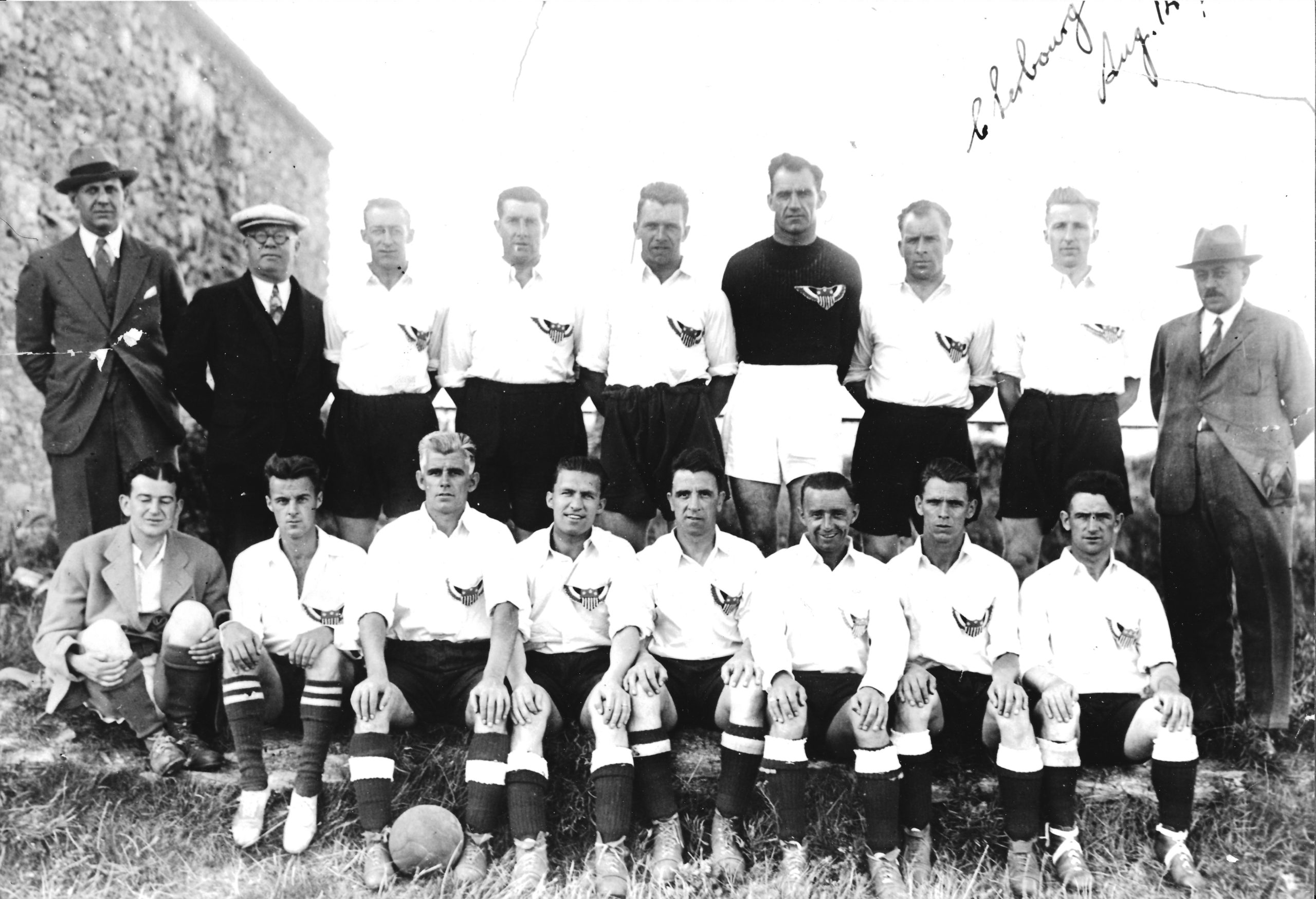
The bitter end
Unfortunately for the Marksman and their fans, fall 1930 would be the last time the Marksmen played. As the 1931 ASL season was about to start in February 1931, Sam Mark decided to take a gamble and moved the team to New York to merge with the New York Soccer Club and become the New York Yankees. The last league game played as the Fall River Marksmen was on January 4, 1931, in a 2-2 draw away at Newark. Mark took this gamble because Fall River was hit hard by the Great Depression and the revenues and attendance at Mark’s Stadium continued to struggle. His gamble proved to be a bad one as New York City was not immune from the effects of the economic calamity.[61]
The starting eleven were primarily Marksmen players with the usual stars Patenaude, Gonsalves, McNab, McAuley, White McPherson and Reder leading the way. George Moorhouse was the only key mainstay from New York. The Yankees would go on to finish the first half of the season with a 9-5-3 record for 21 points while scoring 42 and allowing 27 goals and a win percentage of .619. The New York Yankees soon merged with Fall River FC, the club that replaced the Marksmen, to reform as the New Bedford Whalers the second half of the season starting in September of 1931. New Bedford would win the second half and face the New York Giants in the Championship series and would lose 9-8 in two matches.
Because the team registered for and began play in the 1930-1931 National Challenge Cup as the Marksmen rather than the Yankees, by rule the club could not continue in the tournament as the New York Yankees after the merger in February 1931. This meant the Fall River Marksmen existed only in the remaining rounds of the National Challenge Cup. The merger was made before the team played the Newark Americans in the semifinal and the Chicago Bricklayers in the final series.
The National Challenge Cup introduced a group format for the 1930-31 edition, with the Marksmen competing against Pawtucket, New Bedford, and Providence. In this format, teams played each other twice with the winner of the group advancing to the next round. The Marksmen easily advanced with four victories and two draws. The Marksmen then defeated New York Galicia, defeating them 6-2 in New Bedford. After besting Newark Americans in the semifinals, the Marksmen faced Chicago Bricklayers in a three-leg final. After losing the first leg at the Polo Grounds 6-2 on April 5, 1931, the Bricklayers fought for a 1-1 draw at Mills Stadium on April 12 to force a replay. Despite traveling with only 12 players and playing with ten men, the Marksmen won the replay at Sparta Stadium in Chicago, 2-0 to claim their fourth and final National Challenge Cup championship.[62]
While Fall River would have to wait almost two decades before another club brought success at such a high level, the Marksmen’s achievements are still highly regarded. Consistently drawing large support, the team won every championship it could compete for but the AFA’s American Cup over its short history.
The Fall River Marksmen All-Time Record 1922-1931
Competition Games Played Wins Losses Ties Points GF GA
American Soccer League: 398 277 72 90 544 937 512
National Challenge Cup: 37 29 2 6 —- 134 46
Lewis Cup: 22 10 5 7 —- 44 29
AFA American Cup: 4 3 1 0 —- 12 4
American Association Cup: 2 0 1 1 —- 5 7
________________________________________________________________________
Totals: 454 340 81 104 544 1,132 598
Honors
ASL Titles: 6
National Challenge Cup Titles: 4
Lewis Cup Titles: 1
Endnotes
[1] Roger Allaway, Rovers, Rangers and Spindles: Soccer, Immigration, and Textiles in New England and New Jersey (Haworth, NJ: St. Johan Press, 2005), 40-2, 45.
[2] Colin Jose, American Soccer League 1921-1931: The Golden Years of American Soccer (Lanham, MD: Scarecrow Press, 1998), 11.
[3] ”Cahill Visits City” Fall River Globe, Jul. 20, 1922, 8.
[4] ”Has Option on Soccer Franchise” Fall River Globe, Jul. 24, 1922, 11.
[5] ”Sam Mark Will Enter Football” Evening Herald, Jul. 24, 1922, 12.
[6] New Field for Athletics” Fall River Globe, Jul. 29, 1922, 9.
[7] ”Brittan is Signed for Local Eleven” Fall River Daily Evening News, Sep. 15, 1922, 8.
[8] ”Fall River Soccer Team Holds Practice” Fall River Globe, Sep. 20, 1922, 9.
[9] ”Fall River Score on New Yorkers” Fall River Daily Evening News, Oct. 23, 1922, 5.
[10] “Fall River Soccer Team Buys Fryer” The Boston Globe, Feb. 26, 1924, 7.
[11] ”Takes Little Dig at the Marksmen” The Fall River Evening Herald, Oct. 11, 1924, 13.
[12] ”McPherson Suffers Fractured Wrists” The Fall River Evening Herald, Sep. 8, 1.
[13] “Pennant Raising Scenes at the Stadium” The Fall River Evening Herald, Oct. 20, 1924, 9.
[14] “Marksmen Win Grueling Game” The Fall River Evening Herald, Jan. 26, 1925, 12.
[15] “Marksmen Down Pawtucket Rivals” The Fall River Evening Herald, Feb. 26, 1925, 11.
[16] “Fall River Gets Big Game” The Fall River Evening Herald, Mar. 16, 1925, 11.
[17] “Marksmen Downed By Boston Rivals” The Fall River Evening Herald, Mar. 30, 1925, 7.
[18] “Mark’s Machine Stolen From Him In Montreal” Fall River Evening Herald, Jul. 7, 1925, 11.
[19] “New Stars for Fall River” The Boston Globe, Jul. 24, 1925, 13.
[20] “Shawsheen Buying Up Talent for Soccer” The Boston Globe, Jul. 24, 1925, 13.
[21] “Soccer Teams Lining Up Stars” The Boston Globe, Aug. 5, 1925, 18.
[22] “Soccer Snaps” The Boston Globe, Sep. 28, 1925, 17.
[23] “Soccer Changes Interest Fans” The Boston Globe, Aug. 3, 1925, 9.
[24] “Boston With 10 Men Ties Count” The Boston Globe, Feb. 15, 1926, 11.
[25] “Boston Moves On In Race For Cup” The Boston Globe, Feb. 22, 1926, 9.
[26] “Boston Holds Champs To Tie In Overtime, 2-2” The Boston Globe, Apr. 19, 1926, 6.
[27] “On The Soccer Pitch Here And Abroad” Fall River Evening Herald, Jul. 2, 1926, 22.
[28] “Mark Announced Leader of Team” Fall River Evening Herald, Jul. 9, 1926, 1.
[29] “Brittan to Join New Bedford Club” Fall River Evening Herald, Jul. 19, 1926, 6.
[30] “Prague Eleven Drop First Game” Fall River Evening Herald, Sep. 20, 1926, 10.
[31] “Live Tips and Topic” The Boston Globe, Mar. 10, 1927, 21.
[32] “Fall River Wins Before 14,000” The Boston Globe, Mar. 28, 1927, 9.
[33] “Fall River’s Soccer Win Well Deserved” The Boston Globe, Apr. 4, 1927, 18.
[34] “Fall River Wins Final For Cup” The Boston Globe, Apr. 25, 1927, 10.
[35] “Fall River Wins National Cup” The Boston Globe, May 2, 1927, 10.
[36] “Uruguay And Fall River Play to a 1-1 Tie” The Boston Globe, Apr. 11, 1927, 11.
[37] “Fall River In Bad Over Seas” The Boston Globe, Jul. 14, 1927, 21.
[38] Jose, 156-57, 171, 187.
[39] “Fall River Loses to New Bedford” The Boston Globe, Sep. 26, 1927, 7.
[40] “Douglas Should Aid Marksmen” The Boston Globe, Oct. 8, 1927, 10.
[41] “Providence Gets Gibson, Trades McAuley” The Boston Globe, Dec. 16, 1927, 10.
[42] “Marksmen Eliminate Boston In Cup Contest” The Boston Globe, Jan. 30, 1928, 19.
[43] “Coats vs Nationals In The Eastern Final” The Boston Globe, Feb. 27, 1928, 11.
[44] Jose, 70.
[45] “Meets Whalers In Semi-Final” The Boston Globe, Mar. 5, 1928, 24.
[46] Jose, 156.
[47] “Scottish Champs Are Outplayed” Fall River Herald, Jun. 4, 1928, 17.
[48] Jose, 191.
[49] “Bobby Blair Scores Four Goals to Defeat Brescia” Fall River Herald, Aug. 27, 1928, 13.
[50] Jose, 192.
[51] Jose, 221.
[52] Jose, 262.
[53] Derek Gonsalves, “Footage from the Fall River Marksmen’s 1930 Central European tour,” Society for American Soccer History. Last modified Sep. 9, 2020, https://www.ussoccerhistory.org/footage-from-the-fall-river-marksmens-1930-central-european-tour/
[54] “Carihan Misses Penalty and Stark’s Goal Disallowed” Fall River Herald, Mar. 17, 1930, 10.
[55] “Marksmen Beat Steelmen In Eastern Final Replay” Fall River Herald, Mar. 24, 1930, 1.
[56] “Locals Win By 7 To 2” Fall River Herald, Mar. 31, 1930, 1.
[57] “Glasgow Team Wins Big Game By 3-2 Score” Fall River Herald, May. 31, 1930, 12.
[58] “Scottish Team Easily Beaten By Locals” Fall River Herald, Jun. 16, 1930, 15.
[59] “Local Collapse Under Pressure In Second Half” Fall River Herald, Jun. 23, 1930, 15.
[60] Gonsalves.
[61] Jose, 281.
[62] “Fall River Yankees Win Soccer Title” The Boston Globe, Apr. 20, 1931, 20.

Pingback: Fall River Marksmen Soccer Team fejrer 100 år - Telgraf News
Pingback: The Fall River Shooters football team turns 100 years old – Law Glitz
Pingback: Fall River Marksmen soccer team turns 100 years old - Soccer News
Pingback: Das Fall River Marksmen-Fußballteam wird 100 Jahre alt - Nach Welt
Excellent